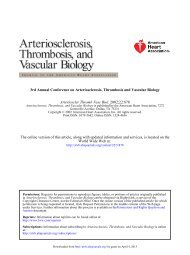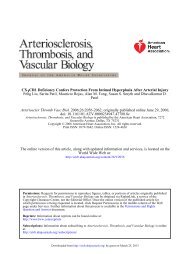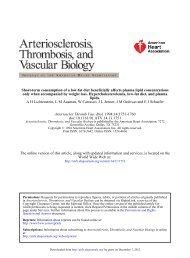Bloch and Richard T. Lee P. Christian Schulze, Heling Liu, Elizabeth ...
Bloch and Richard T. Lee P. Christian Schulze, Heling Liu, Elizabeth ...
Bloch and Richard T. Lee P. Christian Schulze, Heling Liu, Elizabeth ...
Create successful ePaper yourself
Turn your PDF publications into a flip-book with our unique Google optimized e-Paper software.
ole in the pathogenesis of vascular oxidative stress in<br />
diabetes mellitus since hyperglycemia directly induces<br />
Txnip expression in vascular smooth muscle cells. 21,25<br />
The current study reveals a time- <strong>and</strong> concentrationdependent<br />
increase in thioredoxin activity in response to<br />
exogenous administration of NO in RPaSMC. Increased<br />
thioredoxin activity is accompanied by changes in expression<br />
of 2 central regulators of thioredoxin function: thioredoxin<br />
reductase <strong>and</strong> the thioredoxin inhibitor Txnip.<br />
The transcriptional regulation of these molecules is independent<br />
of the NO donor compound applied <strong>and</strong> was<br />
observed in cells stimulated with GSNO, NOC-15, <strong>and</strong><br />
SNAP. Intriguingly, our results demonstrate a<br />
concentration-dependent regulation of these effects up to<br />
500 mol/L of GSNO which is consistent with the NOdependent<br />
increase in thioredoxin activity.<br />
NO signaling targets several transcription factors, ion<br />
channels, G-proteins, protein tyrosine kinases, Janus kinases,<br />
mitogen-activated protein kinases, <strong>and</strong> caspases. 16<br />
NO signals in part via activation of the soluble guanylate<br />
cyclase leading to increased cGMP production. cGMP<br />
effector proteins include cGMP-dependent protein kinase,<br />
cyclic nucleotide-regulated ion channels, <strong>and</strong> phosphodiesterases,<br />
which hydrolyze cGMP <strong>and</strong>/or cAMP. 27 Our<br />
experiments show that the transcriptional regulation of<br />
Txnip <strong>and</strong> thioredoxin reductase by NO are independent of<br />
soluble guanylate cyclase.<br />
Several studies have investigated the transcriptional<br />
regulation of thioredoxin reductase by NO. Park et al<br />
showed induction of thioredoxin reductase expression by<br />
NO <strong>and</strong> peroxynitrite <strong>and</strong> the inhibition of this mechanism<br />
by NAC. 22 Recently, Sakurai et al demonstrated the<br />
induction of thioredoxin reductase by cadmium <strong>and</strong> identified<br />
an antioxidant response element in the thioredoxin<br />
reductase promoter to be responsible for this regulation. 23<br />
They also identified the transcriptional factor Nrf2 as a<br />
mediator of thioredoxin reductase induction in response to<br />
cadmium incubation. These findings are consistent with<br />
our current study demonstrating the redox-dependent activation<br />
of thioredoxin reductase expression by NO. We,<br />
therefore, concentrated our studies on the regulation of<br />
Txnip expression because less is known about the underlying<br />
transcriptional mechanisms controlling Txnip mRNA<br />
expression.<br />
Previously, hyperglycemia has been identified as a<br />
strong inducer of Txnip expression by several<br />
groups. 21,24,25,28 This induction is mediated by a<br />
carbohydrate-response element (also called USF-1 binding<br />
site) 400 bp 5 to the start codon. Promoter deletion<br />
analysis in the current study revealed that cis-regulatory<br />
elements -1127 bp upstream of the start codon mediate<br />
NO’s effects on Txnip expression. Notably, GSNO stimulation<br />
does not affect the induction of Txnip promoter<br />
activity by hyperglycemia, whereas hyperglycemia completely<br />
abolishes NO’s effects on Txnip promoter activity.<br />
Therefore, the induction of Txnip by glucose <strong>and</strong> the<br />
suppression of Txnip by NO are most likely regulated<br />
through different transcriptional elements, which form a<br />
<strong>Schulze</strong> et al NO Regulates Thioredoxin Through Txnip 2671<br />
molecular balance regulating the expression levels of<br />
Txnip in RPaSMC.<br />
The posttranslational modification of proteins by<br />
S-nitrosylation accounts for various biological effects of<br />
NO, 29 <strong>and</strong> proteomic screening for S-nitrosylated proteins<br />
has revealed numerous protein targets which remain to be<br />
functionally characterized. 15,30 Direct activation of thioredoxin’s<br />
antioxidative <strong>and</strong> antiapoptotic activity by NO has<br />
been linked to S-nitrosylation of thioredoxin at Cys69 both<br />
in vitro <strong>and</strong> in vivo. 14, 15 As demonstrated by Haendeler et<br />
al, S-nitrosylation of thioredoxin at Cys69 but not Cys32 or<br />
Cys35 in response to NO increases thioredoxin’s activity<br />
<strong>and</strong> anti-apoptotic effects in endothelial cells. 14 Further,<br />
infusion of S-nitrosylated thioredoxin has been shown to<br />
reduce myocardial ischemia/reperfusion injury 15 <strong>and</strong> to<br />
ameliorate myosin-induced myocarditis. 15 Notably, while<br />
S-nitrosylation reduces caspase activity <strong>and</strong> inhibits apoptosis,<br />
31 S-nitrosylation of Ras increases its activity 32<br />
indicating both enhancement or inhibition of cellular<br />
pathways caused by protein S-nitrosylation. The current<br />
study tested the effect of NO <strong>and</strong> the resulting<br />
S-nitrosylation of thioredoxin on the interaction between<br />
thioredoxin <strong>and</strong> Txnip. These immunoprecipitation experiments<br />
were performed in HEK293 cells because of the<br />
higher efficiency of transfection compared with RPaSMCs.<br />
Since HEK293 cells do not produce NO endogenously, NO<br />
was administered exogenously to the cells to study these<br />
effects. Mutation of the thioredoxin molecule with a<br />
substitution of Cys69 to Ser had no effect on the ability of<br />
Txnip to interact with thioredoxin. Therefore, NO-induced<br />
protein S-nitrosylation of thioredoxin does not inhibit the<br />
interaction with Txnip. We conclude that our findings<br />
reveal a novel mechanism by which NO activates the<br />
thioredoxin system through reduction of Txnip <strong>and</strong> enhanced<br />
expression of thioredoxin reductase.<br />
An important function of thioredoxin is its effects as a<br />
transcriptional co-activator. On nuclear translocation, thioredoxin<br />
interacts directly with NF-B <strong>and</strong> ref1. 5,6 As<br />
previously reported, this mechanism is redox-dependent<br />
<strong>and</strong> can be blocked by antioxidants <strong>and</strong> overexpression of<br />
Txnip. 10,12 Additional experiments have revealed a redoxdependent<br />
translocation of thioredoxin in response to<br />
incubation with GSNO that accompanies the GSNOinduced<br />
suppression of Txnip (data not shown). Intriguingly,<br />
a recent study has demonstrated nuclear localization<br />
of Txnip suggesting that it may also have a nuclear<br />
function. 33 This suggests a role for thioredoxin <strong>and</strong> interaction<br />
with Txnip in the transcriptional events mediated by<br />
NO.<br />
In conclusion, we have demonstrated a novel NOdependent<br />
mechanism of enhanced thioredoxin activity<br />
through suppression of Txnip <strong>and</strong> increased expression of<br />
thioredoxin reductase. Our findings emphasize pivotal transcriptional<br />
effects downstream of NO signaling that contribute<br />
to the anti-apoptotic <strong>and</strong> antioxidative defense of the cell.<br />
Sources of Funding<br />
This work was supported, in part, by grants from the Deutsche<br />
Akademie der Naturforscher - Leopoldina (BMBF-LPD) (9901/8-41<br />
to P.C.S.) <strong>and</strong> from the NIH (PO1 HL64858 to R.T.L.).<br />
Downloaded from<br />
http://atvb.ahajournals.org/ by guest on July 30, 2013














